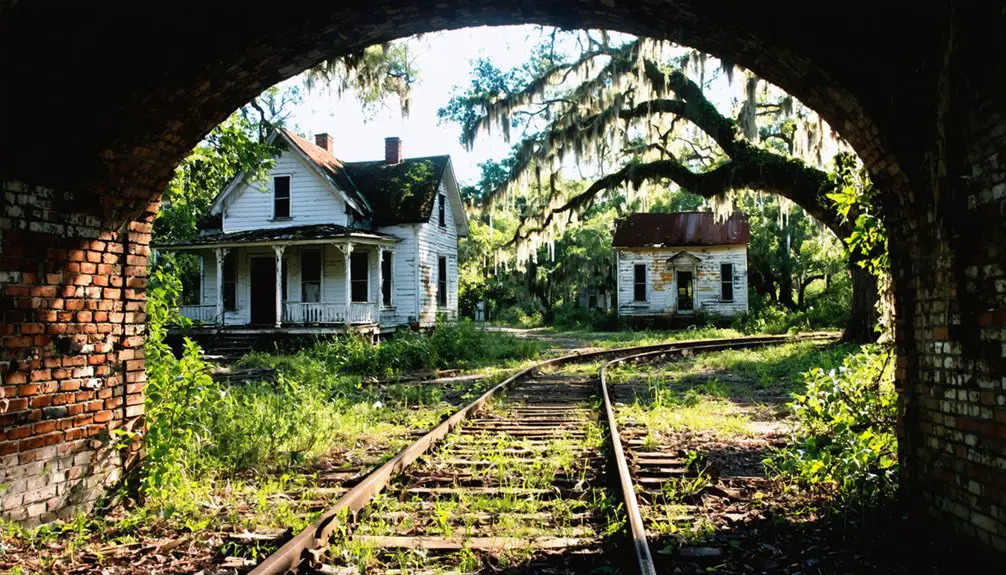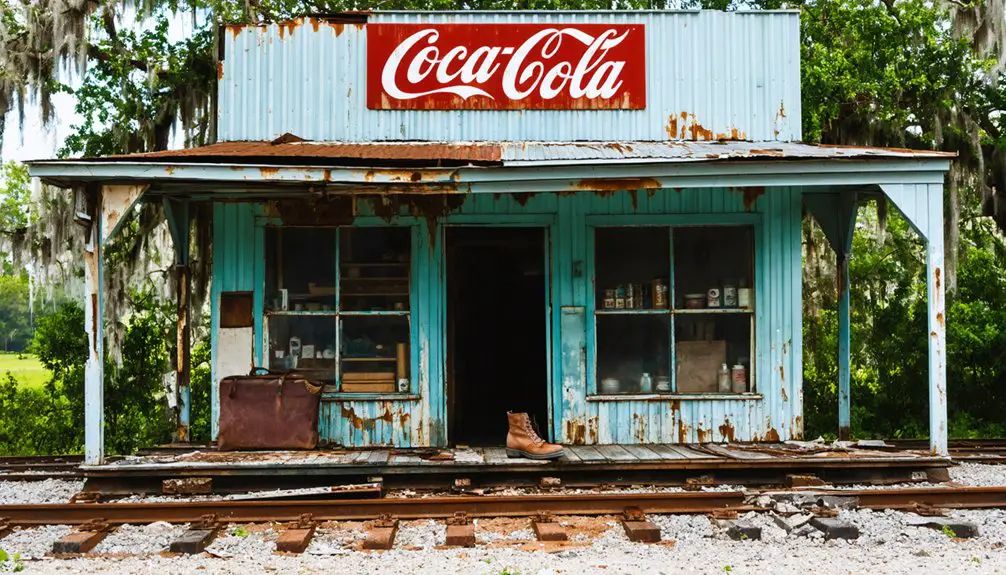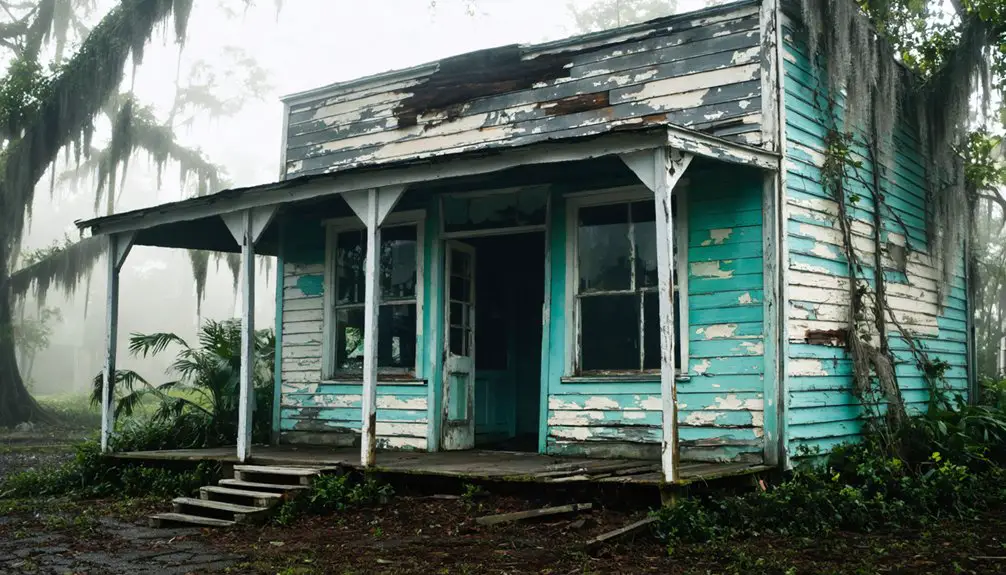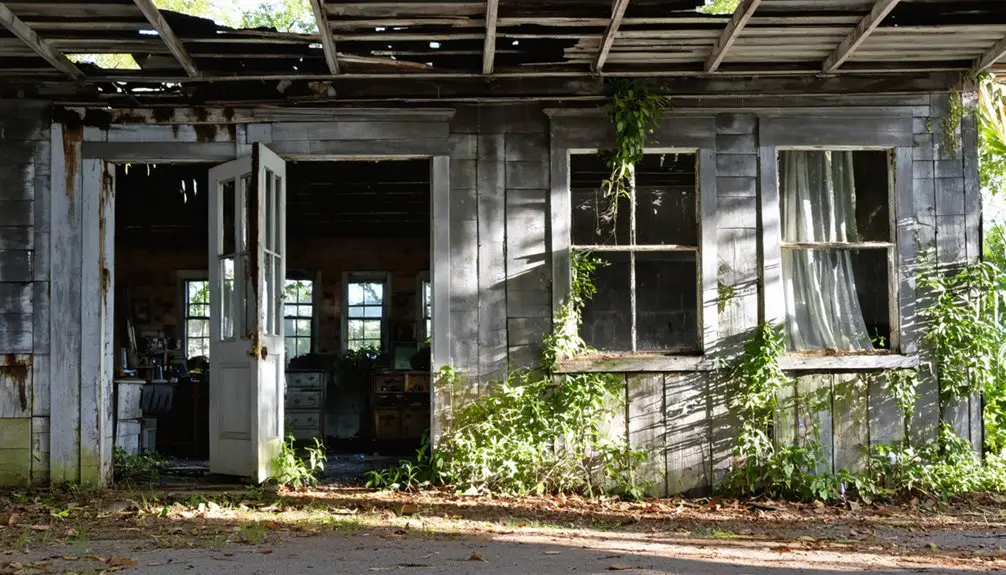You’ll find Edgeville’s ghost town remains in Central Florida, where it thrived as a turpentine hub starting in 1915. The Edge-Howard Company built 75 worker homes and used the innovative Herty cup system for resin extraction from longleaf pines. By 1921, the Manatee Crate Company operated a 5,000-acre mill there, connected by the East and West Coast Railway. After the 1927 Florida real estate crash, Edgeville’s industrial dreams crumbled, leaving behind a fascinating story of boom-and-bust ambition.
Key Takeaways
- Edgeville, established in 1915, was a turpentine company town that later became a ghost town after industrial operations collapsed.
- The town’s economy centered on the Edge-Howard Company’s turpentine production and Manatee Crate Company’s manufacturing operations.
- Approximately 75 company-built structures housed workers in the 1920s before economic hardships led to the town’s decline.
- The 1927 Florida real estate crash significantly impacted Edgeville’s expansion plans, contributing to its eventual abandonment.
- The town transformed from an industrial hub to abandoned land, exemplifying the fate of early 20th-century Florida company towns.
The Rise of a Turpentine Town (1915)
As Florida’s naval stores industry flourished in the early 1900s, Edgeville emerged as a bustling turpentine town by 1915, capitalizing on the region’s abundant longleaf pine forests.
By 1915, Edgeville had grown into a thriving turpentine hub, tapping into Florida’s vast pine forests during the naval stores boom.
You’d find workers employing the innovative Herty cup system, attaching clay cups and metal gutters to extract precious resin from the towering pines.
The town’s turpentine production drew laborers from Georgia and the Carolinas, but you’d witness a dark undercurrent of labor exploitation. Workers were paid in company scrip only, forcing them to make purchases exclusively at inflated company stores.
Many African American workers faced arrest on minor charges, only to be leased to camp owners through convict labor schemes.
Despite harsh conditions and low wages, the industry transformed Edgeville’s economy, attracting lumber companies and spurring settlement growth. The workers produced essential ingredients for household products like soaps, cosmetics, and medicines.
The boom reshaped the area’s demographics and social fabric, marking a pivotal era in local history.
Industrial Development and Railway Connection
Building upon its turpentine foundations, Edgeville’s industrial landscape expanded dramatically in 1921 when the Manatee Crate Company established operations on 5,000 acres of local land.
You’d find a bustling mill processing logs into crates for construction and shipping, marking a significant industrial transformation from the town’s turpentine-producing past.
The East and West Coast Railway‘s significance proved essential, connecting Edgeville to both Myakka City and Pine Level.
This critical transportation link didn’t just move products – it brought workers from Georgia and the Carolinas to fill the 75 company-built housing units.
Like the boll weevil infestation that devastated cotton production in other Southern regions, economic hardships hit Edgeville hard when plans for expansion, including the Manatee Springs subdivision and a golf course, fell through during Florida’s 1927 real estate crash.
Though plans for expansion, including the Manatee Springs subdivision and a golf course, fell through during Florida’s 1927 real estate crash, the railway-industrial partnership defined Edgeville’s peak economic period.
To avoid confusion with other locations named Edgeville, this Florida ghost town was often referred to as Edgeville Junction in railway documents.
Life in the Company Settlement

In Edgeville’s company settlement of the early 1920s, you’d find approximately 75 company-built structures housing workers who spent their days in physically demanding turpentine extraction and crate manufacturing.
Like many communities established after the Civil War hardships, families came seeking fresh opportunities in Florida’s growing industrial towns.
You’d witness strict racial segregation in both housing and schooling, with African American children attending a separate public school while white children traveled to Myakka City for their education.
Your daily life would’ve been tightly controlled by the company, with minimal private property ownership and few amenities beyond basic worker housing and industrial facilities.
Daily Worker Routines
Life in Edgeville revolved around the demanding schedules of its two primary industries: turpentine production and crate manufacturing. You’d start your workday before dawn, heading to either the Edge-Howard Company’s turpentine operations or the Manatee Crate Company’s mill.
If you worked in turpentine, you’d spend long hours tapping pine trees and processing resin in the sweltering Florida heat. At the crate mill, you’d endure exhausting shifts with minimal breaks, processing logs into finished crates. The workers could only look forward to occasional square dancing events on Friday nights to lift their spirits.
Labor conditions were harsh, with no safety protections in place. After your shift, you’d return to company-owned housing, where you’d tend to basic needs and possibly maintain a small garden. Like the recent Pentagon funding proposal for Niceville’s infrastructure, company towns often sought external support for their facilities.
Your movements were restricted by limited transportation options, keeping you tied to the company’s rigid schedule and control.
Housing and Living Conditions
While turpentine workers and crate makers toiled through their demanding shifts, they returned each evening to modest wooden frame houses that offered little more than basic shelter from Florida’s unrelenting climate.
You’d find yourself in a cramped space with basic amenities – a simple kitchen, minimal bathroom facilities, and no air conditioning. Housing modifications became necessary as families struggled against leaky roofs and persistent moisture problems.
Shared outdoor spaces doubled as laundry areas and vegetable gardens, while sanitation issues plagued the community due to primitive sewage systems and inadequate waste disposal. Similar to modern developments, residents dealt with setback requirements of 7.5 feet between homes to maintain neighborhood standards.
The company’s control extended to your living space, with homes arranged in uniform rows based on job rank, keeping you under constant supervision while limiting your access to independent community services. Much like recent concerns over affordable housing locations, these living arrangements perpetuated issues of inequity and lack of choice for residents.
Company-Controlled Social Structure
As the Edge-Howard Company established Edgeville in 1915, you’d find yourself living under a tightly controlled social structure that dominated every aspect of daily life.
The company’s influence extended from your housing to your children’s education, creating a rigid social hierarchy that divided the community along racial lines. You’d notice African-American children attending a separate local school established in 1919, while white children had to travel to Myakka City for their education.
By the early 1920s, when Manatee Crate Company took control of the 5,000-acre settlement, you’d see only 19 households remaining, mostly comprising workers tied to the company’s operations.
The transient nature of the workforce and limited family presence reflected the company’s grip on social organization and community development.
Educational and Social Dynamics

You’ll find that Edgeville’s 1919 educational landscape reflected Florida’s segregated reality, with African American children attending a local public school while white students traveled to Myakka City’s facilities.
The town’s school system faced significant rural challenges, operating with limited resources and serving only about 19 households by the early 1920s.
Similar to Ellaville’s earlier prominence with its steam-operated sawmill, the African American community played a vital role in shaping the town’s development.
Within this small company settlement, the African American school emerged as an essential community institution, though it ultimately ceased operations as Edgeville’s population declined.
Segregated School Systems Emerge
Following the landmark 1954 Brown v. Board of Education decision, you’d have witnessed Edgeville’s transformation as segregated education took root through private academies.
These schools emerged specifically to circumvent integration mandates, mirroring resistance patterns across Florida and the South. The state legislature supported these institutions by channeling public funds and tax credits their way, deepening racial inequities in the community.
You’d have seen Black students in Edgeville facing limited options – some attended makeshift schools in local churches while others traveled long distances for education.
Meanwhile, white families withdrew their children from public schools, enrolling them in private academies that maintained racial separation. This system reflected broader Southern strategies, including those modeled after Prince Edward County’s school closures in Virginia.
Community Education Access Challenges
While Edgeville’s location between Myakka City and Pine Level offered strategic industrial advantages, it created significant barriers to educational access in the 1920s. The town’s geographic isolation, combined with limited transportation options, severely restricted community engagement and deepened educational disparities between white and African-American students.
Key challenges that impacted education access included:
- Lack of reliable roads and public transit preventing after-school activities
- Closure of essential services like the post office in 1918
- Limited tax base restricting school resources and teacher recruitment
The company town’s focus on turpentine and crate manufacturing prioritized labor over education. Without retailers, community buildings, or social institutions, Edgeville’s residents faced mounting obstacles to quality education, particularly affecting African-American families tied to the local workforce.
Rural Learning Limitations
Educational challenges in Edgeville persisted well beyond the initial infrastructure problems of the 1920s, evolving into complex rural learning limitations that shaped the community’s educational landscape through the mid-20th century.
You’d have found stark digital barriers affecting Edgeville’s students, particularly as modern education began shifting toward technological solutions. The town’s isolation created significant educational inequality, with limited course offerings and fewer advanced learning opportunities compared to urban centers.
Local teachers struggled with professional development and collaboration, often working in isolation without peer support. The situation worsened as transportation challenges prevented students from accessing educational programs in neighboring communities.
Poverty and geographic isolation combined to restrict students’ participation in enrichment activities, while the lack of reliable internet connectivity later hampered attempts to modernize the learning experience.
Economic Shifts and Challenges

Founded in 1915 as a turpentine company town, Edgeville’s economy initially revolved around the Edge-Howard Company’s turpentine operations along the East and West Coast Railway.
A forgotten Florida town born from turpentine dreams, Edgeville flourished briefly along railway lines before fading into history.
Economic vulnerability became evident as workers fell into debt through company commissaries, limiting their financial freedom.
By 1921, you’d have witnessed these key economic shifts:
- Manatee Crate Company’s arrival, establishing a 5,000-acre wood manufacturing operation
- The devastating 1927 Florida real estate crash that halted development
- A shift to agricultural activities as industries collapsed
Despite agricultural resilience through dairy farming, nurseries, and ranching, Edgeville couldn’t recover from its industrial decline.
The town’s dependence on single industries, coupled with restrictive labor practices and the real estate market collapse, ultimately led to its transformation into a ghost town.
The Abandoned Dreams of Manatee Springs
Beyond its role as a turpentine town, Edgeville’s proximity to Manatee Springs sparked ambitious development plans in 1926. Developers envisioned a thriving residential community that would transform the rural landscape into a bustling subdivision, complete with a golf course designed to attract new residents.
But you won’t find these grand amenities today. The Florida real estate crash of 1927 shattered these economic aspirations, leaving behind only fragments of the planned infrastructure.
The Manatee Springs subdivision joined countless other failed Florida developments of the 1920s, victims of speculative excess and market collapse. While the springs themselves would later become Florida’s first spring-dedicated state park in 1968, the dreams of a residential paradise around Edgeville remained forever unrealized, preserved only in the ghostly remnants of abandoned plans.
Legacy of a Lost Florida Community

While the failed Manatee Springs development marked one chapter of Edgeville’s story, the town’s broader legacy tells a tale of Florida’s evolving industrial landscape.
Today, you’ll find little evidence of the once-bustling company town that shaped the cultural heritage of early 20th century Florida.
The community’s identity lives on through:
A town’s essence endures through its stories, its struggles, and the footprints left by those who shaped it.
- Its name, which preserves the memory of the Edge-Howard Company’s industrial vision
- Its evolution from turpentine camp to agricultural land, reflecting Florida’s economic shifts
- Its historical significance as an example of racial segregation and company town life
Where worker housing and mill operations once stood, you’ll now see dairy farms, nurseries, and ranches.
Edgeville’s change from industrial hub to ghost town mirrors countless other Florida communities that rose and fell with changing economic tides.
Frequently Asked Questions
Are There Any Remaining Original Structures From Edgeville Still Standing Today?
You’ll find six pieces of original architecture still defying time – the Baldwin House, Jimmy Ellenburg House, Bay Chateau, Hicks House, A-Frame House, and Powerboat Club, all under historical preservation with permit-only access.
What Happened to the Former Residents When the Town Declined?
When the town declined, former residents mostly moved to nearby Myakka City for better opportunities. You’ll find their descendants scattered throughout the region, having shifted from turpentine work to farming and ranching.
Was Edgeville Ever Officially Incorporated as a Municipality?
No, you won’t find evidence of official incorporation in Edgeville’s history. The town operated solely under company governance as an Edge-Howard enterprise, without establishing municipal status or local government structures.
Can Visitors Access the Former Edgeville Town Site?
Through winding forest trails, you’ll find the town site easily accessible within Suwannee River State Park. Follow marked paths past historical markers to explore the ruins, though guided ghost tours aren’t currently offered.
Were There Any Notable Crimes or Scandals in Edgeville’s History?
You won’t find documented Edgeville crimes or scandals, though prison labor was used in its turpentine camps in the early 1900s. Records don’t show specific criminal incidents or major controversies.
References
- https://en.wikipedia.org/wiki/Edgeville
- https://www.youtube.com/watch?v=3mDsPKA4B2o
- https://cdm16681.contentdm.oclc.org/digital/api/collection/p16681coll2/id/8444/download
- https://en.wikipedia.org/wiki/List_of_ghost_towns_in_Florida
- https://www.ghosttowns.com/states/fl/edgeville.html
- https://floridatrailblazer.com/tag/turpentine/
- https://dunnhistory.com/the-brutality-of-floridas-turpentine-industry/
- https://lflank.wordpress.com/2023/11/14/floridas-turpentine-industry/
- https://www.youtube.com/watch?v=H_lFcSJv14Y
- https://www.historicedgefield.com/historical-overview



